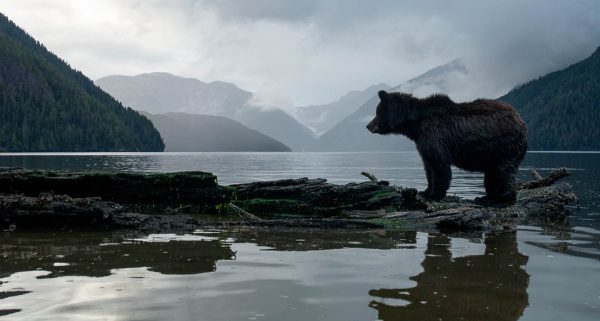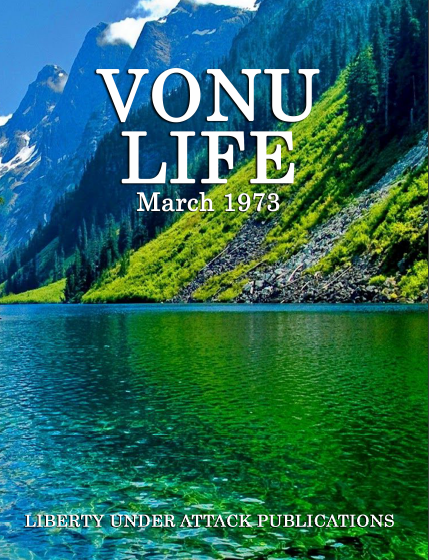The following is another article by Rayo out of VONULIFE, March 1973 that will accompany the upcoming episode of Liberty Under Attack Radio, as well as the next Patreon exclusive for vonu listeners. Please make sure to check out this LUA Radio episode for an introductory discussion on this subject.
One other note: VONULIFE is completely transcribed and is now in the “hands” of proofreaders/editors. The full publication should be released very soon!
Ethical Land Use
By: Rayo
As a vonuist my policy is non-coercion – live and let live. So long as another human does not do or threaten violence, I do not intentionally interfere with that person or with artifacts he creates or acquires with the consent of the one who creates.

Artifacts include structures upon or under land – a home, factory or garden. But naturally-occurring land itself is not created by the deliberate efforts of any being. So what claims to land or uses of land may I properly make? I will begin by scrutinizing some traditional answers to this question.
One doctrine holds that land belongs to the first person who uses it (or discovers it and claims it). Some people assert that this is the only truly moral doctrine – i.e., consistent with non-coercion. But actually it is arbitrary. How does a person who first gathers wild berries in a particular valley gain a right to exclude or collect rent from others who wish to gather berries or plant turnips? E can claim the particular berries e gathered. But er action does not create more berries nor trees nor soil. Likewise, someone who grows a crop may claim the harvest as well as ‘improvements’ to the land such as clearing and terracing (so long as these improvements endure) but does not thereby gain any right to interfere with others who make non-conflicting uses.
This doctrine is not only arbitrary in theory but capricious if not unworkable in practice. Very little if any land in the world today is used with the consent of first users. Typically, a tract of forest is ‘owned’ by a lumber company which bought it from a government 50 years ago, which seized it from an Indian tribe 150 years ago, which seized it from another tribe 500 years ago, which seized it from still another tribe 2000 years ago. Further investigations may show that the land was held by still another tribe 10,000 years ago. And so forth.
Under ‘first-user’ doctrine most of North America would belong, not to ‘the Indians’, but to just a FEW Indians. There is archeologic [archeological] evidence of at least five different waves of immigrants across the Bering Strait thousands of years apart. In all probability, descendants of the first group multiplied and used most of the continent; subsequent comers were ‘trespassers’.
In many cases the original tribes have vanished – destroyed by enemies, epidemics, or hardships endured upon being forced out by ‘their’ lands by a stronger tribe. Individual survivors scattered among other tribes and intermarried. Determining original users and their closest surviving kin, after tens of thousands of years, would be extremely difficult to say the least. In a society where ‘first user doctrine’ was consistently applied, there would be as many archeologists and paleo-geneticists as there are lawyers today.
This is not to deny that great wrongs were inflicted upon many Indians by Europeans (principally the U.S. government) or that restitution should be made. It is to deny that first-user doctrine provides a proper way of deciding who should own what today. Being dispossessed of land was, in many instances, the least of the damages inflicted: Indians were also murdered and their children were, and ARE forced into state schools.
A second doctrine asserts that land belongs to the first person able to use it ‘intensively’ – i.e., cover it with improvements. By this doctrine a farmer has the right to seize land from a tribe of foragers.
But this doctrine is as arbitrary as the first and raises such questions as, What constitutes an ‘intense’ use? May a government seize (‘condemn’) the farmer’s fields to build an airport?
This doctrine is most applicable to ‘built up’ areas – houses and factories – where the ‘improvements’ (artifacts) may be more valuable than the land. It isn’t relevant to wilderness land.
A third doctrine of land ownership asserts that, since no individual created land, land is owned by ‘society as a whole’ or ‘all the people’. But this merely compounds the absurdity. If NO person created land, how did ALL people do so?
In practice, since little if anything is done with the unanimous consent of all people, some ruling group attempts to control land in the name of ‘the people.’
This leads to the fourth doctrine: sovereign control of all land belongs to governments, either by ‘devine [divine] right’ (in the case of absolute monarchs) or by the (equally mystical) ‘will of the people’ Governments then delegate plots of land to favored subjects.
This is the least tenable doctrine of all: a fictitious title is, in essence, transferred to a government by an equally fictitious contract. Furthermore, since most governments on earth are essentially monster criminal conspiracies – guilty of wholesale murder and robbery, any property such a government might otherwise claim, is forfeit as restitution to its victims. Unlike other land users, a government does not even have a moral claim to structures it may put on land.
Since a government has no moral right to land, no one has a moral claim by virtue of assignment by government – i.e., ‘legal title’.
My land-use ethics: No one created naturally-occurring land. Therefore no one owns land per se. Any ‘rights’ pertain, not to the land itself, but to SPECIFIC USES of land. Therefore, morally, I MAY USE LAND IN ANY WAY WHICH DOES NOT SERIOUSLY INTERFERE WITH OTHER USES ALREADY BEING MADE, EXCEPT AS I MAY OTHERWISE AGREE.
The exception is important. It includes renting, leasing, caretaking or being a guest. If I go onto some land at the invitation of another, I thereby recognize high right to control my use of that land. This is true regardless of what ‘right’ e may have to the land – i.e., whether or not e has ‘legal title’, whether or not e dispossessed earlier users, or whatever.
This doctrine is not without elements of arbitrariness. For example, what constitutes ‘serious interference’? And in event of a dispute who decides? But all concepts involving human action have ‘boundary problems’.
Broad categories of uses to consider: (A) Relatively ‘visible’ uses of land such as conventional construction, farming, logging, mining and road building. (B) Relatively vonu uses such as hiking, foraging, camping, gold-panning and hidden construction.
The visible uses are vulnerable to organized predators (sometimes to unorganized ones as well). Visible users can operate only with the consent of such predators. To minimize my involvement with criminal organizations I must minimize my visibility including visible uses of land.
Situations of possible conflict: (1) vonu use concurrent with visible use; (2) two or more possible vonu uses.
Example of the first: Suppose I wish to build a concealed home on land ‘owned’ and periodically cut over by a lumber company. I do not recognize the company’s ownership of the land per se; however I respect the use they are already making of it – to do otherwise would involve me in power games of that society. So I do not attempt to cut and sell commercial-size timer. Nor do I, without provocation, interfere with the company’s operation.
To the contrary, I am probably mildly beneficial to the company, while remaining independent of it and (most likely) unknown to it. I eat porcupines which gnaw trees. I try to put out any fires started by lightning (as well as being very careful with any fires of my own). I use only dead or crowded-out-and-dying trees for my construction – primarily to avoid visible alteration, but this also reduces fire hazard and speeds growth of remaining trees. I may make minor repairs to access roads. In a sense I become a kind of benevolent wildlife; perhaps as desirable (from the point of view of the company) as a bird which eats pine beetles, but even more ‘uncontrollable’.
The lumber company’s use may also benefit me. An area they cut may, after a few years, be lush with berries and game. After a few more years it will be a dense thicket of young trees and brush – an ideal vonu homesite. And their logging trails may be useful for occasional access to that society.
I try to be beneficial or, at least, non-injurious, because vonu is always relative. The company could, at great expense, hunt me down, chase me out, or at least force me to take measures which would seriously inconvenience me.
The company may be completely unaware of my presence. Or they may suspect that someone is using the land but not know who, when or where (weekend recreationists may also use it). So long as I am benign they are well advised not to pursue the matter further. ‘Declaring war’ on a vonuan would be highly unprofitable. They could bring greater forces to bear – perhaps many men with dogs and helicopters – but they must pay these forces. And the property of mine which they could seize – if they could find it – is of little value to them. Whereas they have large amounts of valuable and vulnerable property – equipment, roads and the trees themselves – all out in the open. While I will not deliberately initiate violence I will happily retaliate. If someone deliberately interferes with my uses, I no longer feel obligated to respect er uses.
This analysis applies also to land claimed by a government agency, except that the government (unlike most lumber companies) is a coercive organization and so does not have a clear claim to ‘improvements’ it may make.
Might it not be easier for me to get the company’s permission to camp on their land, in return for caretaking? Then I could dispense with some of my security precautions. But to the degree that I become involved with visible users of land I partake of their vulnerability. What effect might my occupancy have on their insurance? If I fell and hurt myself could I sue? If I have school-age children, could the company be charged with contributing to the delinquency of minors? And, if they know where I am, will they tell others?
The usual experiences of vonuans with large companies: If one asks permission to squat, or even rent, e will be turned down. But if one goes ahead and does it without asking, and is later discovered, at most e will be told to move, quite often e is allowed to remain.
The second type of situation which could result in conflict: two or more unrelated vonuans attempt to use the same land. There is so much relatively-unused land compared to the number of vonuans that I don’t think this will be much of a problem on the foreseeable future, except possibly for those who hope to obtain all their food by hunting and foraging. In Siskiyou region alone there is about 30,000 square miles of uninhabited forest, brushland and high desert – enough to provide 10,000 groups with three square miles each. Nevertheless I will consider some possible cases.
If the vonuans are of the same subculture they will probably have conventions regarding land use, including pre-agreed-upon arbitrators to resolve any disputes. They may have secret signs – intelligible only to others of their kind – meaning, “This land is already being used for ____. No trespassing for conflicting uses.”
Another possibility: life-styles may be so different that the vonuans, if skilled, rarely or even encounter each other or their artifacts. If they do, they will be inclined to leave alone, so that they will be left alone.
I cannot predict the techniques which vonuans may use in the future nor the conventions regarding property which may develop. But, unlike visible people, avoiding conflict by diversifying uses will usually be more advantageous than fighting over who shall make a particular use. Most forms of combat increase the visibility of the combatants (e.g., explosives, stockades) and their vulnerability to third parties, and so are not compatable [compatible] with vonu.
This doctrine of land use is similar to the conventions of other life. Many species are territorial: bears have territories; humming birds have territories. But territorial defense is directed mainly against unrelated members of the same species – i.e., individuals attempting to make similar uses. A bear does not attempt to keep humming birds out of its territory, or vice versa. The tendency of life is to diversity – to minimize conflict.


2 Replies to “Ethical Land Use by Rayo (VONULIFE, March 1973)”